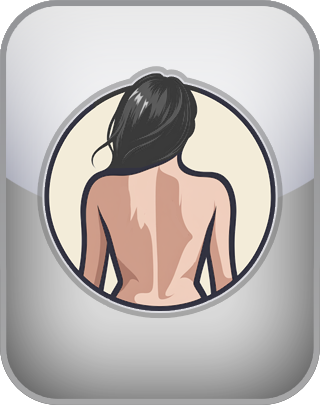Academically reviewed by Dr. Sabina Alispahić, Ph.D., professor of psychology
Body Dysmorphic Test
Body Dysmorphic Disorder (BDD) is a condition characterized by obsessive concerns and distress over perceived flaws or defects in one's physical appearance, which may in reality be minor or even nonexistent. Individuals with BDD are excessively preoccupied with their appearance, leading to significant emotional distress and impairment in daily functioning.
It's important to note that individuals with BDD may not see their concerns as excessive or irrational, and the perceived flaws are often not noticeable to others. BDD can lead to significant emotional distress, depression, and anxiety and may coexist with other mental health conditions.
Are you showing signs of body dysmorphic disorder? For each of the following questions, indicate how well it applies to you.
Question 1 of 32
I spend a significant amount of time looking at myself in mirrors.
| Disagree | Agree |
NEXT
The IDRlabs Body Dysmorphic Test was based on the Diagnostic and Statistical Manual for Mental Disorders, 5th edition, and developed by IDRlabs.
Body Dysmorphic Disorder (BDD) is considered a relatively uncommon mental health condition compared to more prevalent disorders. Estimates suggest that approximately 1% to 2% of the general population may experience Body Dysmorphic Disorder. It can affect individuals of all ages, genders, and ethnicities. BDD often emerges in adolescence or early adulthood, but it can also begin in childhood.
It's important to recognize that BDD may be underdiagnosed, as individuals may feel embarrassed or ashamed to seek help due to the nature of their concerns. Additionally, symptoms may not always be recognized by healthcare providers or may be mistaken for other conditions. Risk factors for developing BDD may include a history of childhood teasing or bullying related to physical appearance, societal pressures regarding body image, and genetic factors that contribute to vulnerability to anxiety and obsessive-compulsive disorders.
Body Dysmorphic Disorder (BDD) is characterized by preoccupation with perceived flaws or defects in physical appearance, leading to significant distress and impairment in daily functioning. Individuals with BDD experience persistent and intrusive thoughts about perceived flaws or defects in their appearance. These thoughts are distressing and time-consuming, often dominating their mental focus throughout the day.
Those with BDD engage in repetitive and compulsive behaviors related to examining their appearance. This may include spending long periods looking in mirrors, checking their appearance on reflective surfaces, or using excessive grooming techniques in an attempt to address or conceal perceived flaws. People with BDD frequently compare their own appearance to that of others. This may involve scrutinizing the features they consider flawed and seeking reassurance from others about their appearance. The comparisons often lead to feelings of inadequacy and heightened distress.
BDD is associated with repetitive behaviors aimed at fixing or hiding perceived flaws. These behaviors may include excessive grooming, skin picking, applying makeup, or seeking cosmetic procedures. Despite engaging in these behaviors, the individual's distress persists. Due to concerns about their appearance and fear of judgment, those with BDD may avoid social situations or activities. This avoidance is driven by the belief that others will notice and negatively judge their perceived flaws.
BDD significantly impairs daily functioning, impacting social, occupational, and other areas of life. Individuals may struggle with relationships, work, or school due to distress and preoccupation with their appearance. BDD has a substantial negative impact on the overall quality of life for individuals affected. Persistent distress, anxiety, and depression may accompany the preoccupation with appearance, leading to a reduced ability to enjoy life.
Individuals with BDD often lack insight into the excessive nature of their concerns. They may not recognize that their perceived flaws are not as noticeable to others as they believe. This lack of insight can contribute to the challenges of diagnosis and treatment. It's important to note that BDD symptoms can vary in intensity and manifestation among individuals. Additionally, the disorder may coexist with other mental health conditions, such as depression or anxiety. Diagnosis and treatment by mental health professionals, including psychologists and psychiatrists, are crucial for individuals struggling with BDD to receive appropriate support and intervention.
In summary, BDD is characterized by a preoccupation with perceived flaws in physical appearance, leading to significant distress and impaired functioning. Key symptoms include persistent thoughts about appearance flaws, excessive self-scrutiny, repetitive behaviors to address perceived flaws, avoidance of social situations, and a negative impact on overall quality of life. Individuals may lack insight into the exaggerated nature of their concerns. Diagnosis and treatment by mental health professionals are essential for those affected by BDD.
As the publishers of this free test, which allows you to screen yourself for the characteristics of BDD, we have strived to make the test as reliable and valid as possible by subjecting this test to statistical controls and validation. However, free online quizzes such as the present test do not provide professional assessments or recommendations of any kind; the test is provided entirely “as-is.” For more information about any of our online tests and quizzes, please consult our Terms of Service.

 English
English  Español
Español  Português
Português  Deutsch
Deutsch  Français
Français  Italiano
Italiano  Polski
Polski  Українська
Українська  Русский
Русский  Türkçe
Türkçe  العربية
العربية  日本語
日本語  한국어
한국어  ไทย
ไทย  汉语
汉语  हिन्दी
हिन्दी  Bahasa
Bahasa 